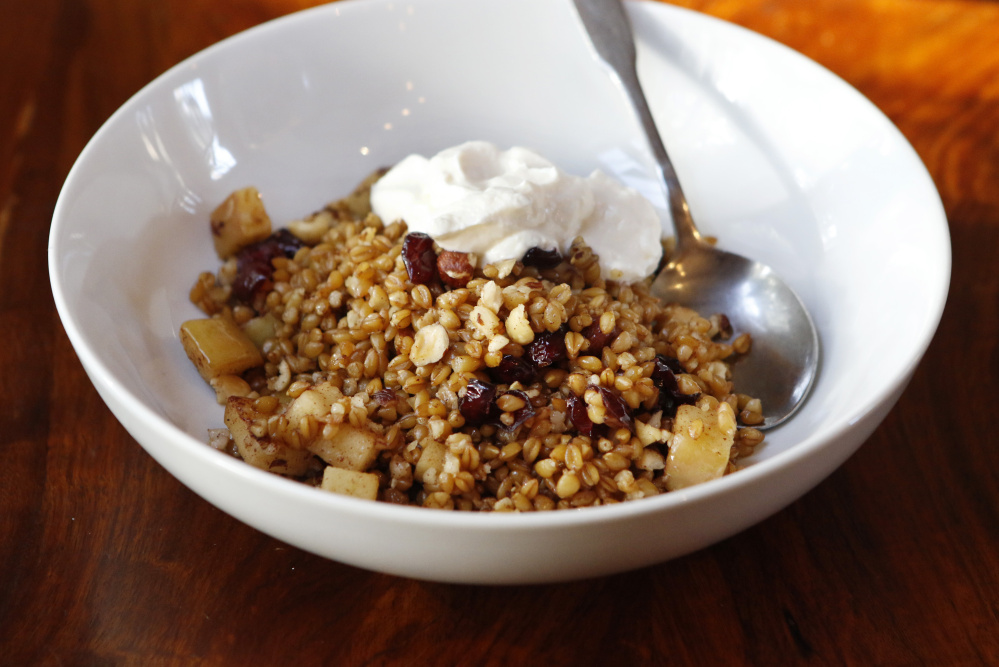The final lap in my formal culinary school training came by way of an 18-month stint on the line at a regional Italian restaurant called Piatto in my then-hometown of Carlisle, Pennsylvania. The pasta was made from durum wheat, a traditional flour used by Italians for the trofie we tossed with pesto and potatoes, the bucatini tubes that squirmed in and out of the spicy all’ Amatriciana sauce, and the spaghetti swimming with garlic, white wine and clams.
But my favorite wheat-based dish was a salad made with farro, an ancient varietal still in its berry form that we boiled softly in large batches and tossed with a simple vinaigrette and seasonal vegetables. The farro released the tiniest bit of starch, allowing us to mold the salad using a section of PVC pipe to sit prettily on the plate. The magic of farro for me is that is provides a satisfying chew.
Farro was my gateway grain, actually. Since I left the line at Piatto, I’ve made a habit of boiling a big pot of whole kernels – barley, emmer, farro, kamut, rye, spelt, or wheat berries, on the weekend and using them throughout the week whenever a salad requires substance, a simmered dish needs to stretch for an extra eater, or a main cries out for an effortless side. The cook once, use many times cooking method of these often locally sourced grains (Maine Grains sells both rye and wheat berries) increases the green quotient of my meals. The high-fiber quotient sustains me, containing cravings for processed foods.
I learned the history of and logistics involved in cooking and keeping whole grains from Maria Speck, who’s written two cookbooks on the topic, “Ancient Grains for Modern Meals” and “Simply Ancient Grains.” She clearly outlines the grain-to-water ratios and cooking times. For example, for every cup of rye berries, you’ll need 1 1/2 cups water and 50-60 minutes on the stove, while a cup of spelt berries requires 1 3/4 cups of water and 45-55 minutes in the pot.
Speck’s approach to soaking the kernels first and then simmering them in plain water (adding salt at the end of the process) is straightforward, using a heavy-bottomed pan with a tight-fitting lid. All wheat benefits from a bit of steam. Once the grains are simmered until soft but still chewy, you slap a lid on the pot, remove it from the heat and let it sit for 10 minutes before fluffing the grains with a fork. Speck says about 15 percent of the kernels will have burst at this point, but she maintains they add a succulence to all dishes they go into.
Storing cooked whole grains is an even easier prospect. Once the grains are steamed, remove the cover, let them cool to room temperature, and then store them in the refrigerator for five days or in the freezer for up to three months. Chilling will harden the starch in many grains, causing them to clump, but they easily break up after reheating (on the stove in a bit of water or in the microwave on high in a bowl).
I must admit to tossing Tupperware containers full of whole grains that had been pushed to the back of the fridge early in my love affair with farro. But as the process of considering all sorts of simply cooked grains as a better option to boiling up yet another pan of white rice, pasta or potatoes has worked its way into my muscle memory, that waste has been curtailed and many dinners have been upgraded in taste and sustainability.
WARM FARRO BREAKFAST BOWL WITH APPLES, CRANBERRIES AND HAZELNUTS
My husband bought me a Fitbit for Christmas. Don’t gasp, it was my idea. More exercise makes me noticeably hungrier, so I’ve expanded my typically tea-only breakfast to include whole grain berries. This recipe, from Megan Gordon’s “Whole Grain Mornings: New Breakfast Recipes to Span the Seasons,” is quick (it relies on previously cooked whole grains), delicious and filling.
Serves 2
1 large firm, sweet apple like honeycrisp or pink lady, diced
2 tablespoons butter
¼ teaspoon ground cinnamon
1 cup cooked farro
¼ cup chopped, toasted hazelnuts
¼ cup dried cranberries (sweetened or unsweetened)
¼ cup Greek yogurt
¼ cup honey
In a small skillet over medium-high heat, sauté apples in butter for about 5 minutes, until they soften and become slightly golden. Stir in cinnamon. Add farro, hazelnuts and cranberries and toss.
To serve, scoop a heaping portion of farro into each bowl and top with a spoonful of yogurt and a generous drizzle of honey. Serve warm.
Christine Burns Rudalevige is a food writer, recipe developer and tester, and cooking teacher in Brunswick. She writes about feeding her family Maine seafood at familyfish.net. Contact her at cburns1227@gmail.com.
Send questions/comments to the editors.



Comments are no longer available on this story